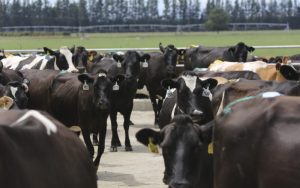
The sheep milking industry is seeing rapid growth in New Zealand, with the number of sheep milk producers increasing by 50 per cent between 2019-2021.
And with New Zealand’s reputation for clean, pasture-based, natural and wholesome products, our sheep milk can be sold for a premium.
The centuries-old practice, made popular in Mediterranean countries such as Turkey and Greece, is cited as a more sustainable alternative to traditional dairy farming, with superior nutritional benefits to boot.
Sheep’s milk infant formula is easier for babies to digest, due to the fat and protein components. It contains only A2 beta casein, which is suitable for those who react to the A1 beta casein in cow’s milk. Its fat is also naturally homogenised, and has smaller globules and more medium chain triglycerides (MCT) which are easier to digest.
The high calcium content in sheep’s milk helps with the prevention of osteoporosis, and its fat profile is also thought to assist cholesterol reduction – a plus point for adult and older consumers.
Nutritional profile aside, sheep milking has some huge benefits in the environmental space as well.
New Zealand Crown Research Institute AgResearch has been heavily involved with Sheep Milk NZ to determine the environmental footprint of sheep dairying, with a specific focus on Nitrogen (N) leaching and GHG emissions.

Studies in 2017 and 2018 looked at N leaching on farms near Taupo in the North Island and Telford in the South Island. There was 50 per cent more pasture growth and N cycling in the sheep treatment compared to cow farms.
Scientists attributed this to less compaction of the soil and more even spread of urine. Urinary N extraction (kg/ha) was 50 per cent less for sheep than cows, too.
To address GHG emissions, AgResearch compared two cow systems with five sheep dairy systems; dry matter intake (or production intensity) was the key driver of GHG emissions.
Although emissions per kg milk solids were similar between sheep and cow, sheep dairying had a significantly higher return per hectare, demonstrating that less intensification and reducing farm GHG emissions is possible.
If sheep milk has a smaller environmental footprint than traditional dairy farming, then the time is right for diversification – but New Zealand is taking a pragmatic approach.
The industry is working hard to improve efficiencies, reduce costs and focus on sustainability – namely soil and water integrity, product traceability, nutrient-dense pastures, and increased output.
A large part of this is creating engineering processes that keep New Zealand at the forefront of food production – and GEA Farm Technologies New Zealand is leading the way in developing sheep milking technology.
GEA offers the complete process line: from gentle and safe milk extraction to innovative machinery that processes milk into various products (powders, cheeses, food products), through to packaging them ready for market.
The team works closely with industry specialists AgResearch, SheepMilk New Zealand, Spring Sheep Milk Co, Maui Milk and the steadily growing group of sheep milking farmers to ensure GEA products are fit for market, enhance throughput, support better efficiency, profitability and sustainability on farm and ultimately meet GEA’s vision of ‘engineering for a better world’.

GEA sheep milking solutions support better milking practice, including automatic cluster removal, milk yield indication and herd management software. That’s in addition to feeding systems, manure management, milk cooling and storage, dairy hygiene and readily available technical support. In a nutshell, GEA offers farmers the baseline innovation and technology necessary for less intensive, higher output farms.
Even better, these high-throughput, animal-friendly milking parlours for the smaller ruminants (sheep and goats) can be easily retrofitted into existing bovine sheds – rotary or double-up parlours – minimising the cost of conversion.
New Zealand farmer Rhys Darby is a recent convert to sheep milking – switching due to the increasing environmental pressure on traditional dairy. With GEA’s support, he has successfully converted a 36-a-side herringbone traditional dairy parlour into a 42-a-side sheep milking parlour with rapid-exit stalling.
The retrofitted GEA sheep milking system, with in-shed feeding, automated plant technology and rapid-exit stalling was designed for ease of use and maximum milking efficiency.
“We get excellent throughput,” Darby says. “Milking takes roughly five minutes per row, so we’re milking 600 ewes in just over an hour with one to two labour units.”
The future of the sheep milking sector in New Zealand is exciting. Due to the current scale and cost, only a minimal amount of sheep milk is being made into milk powder around the world – but there is a growing market for this more sustainable, highly nutritious product.
Clean, green, quality farming systems, being environmentally-friendly and profitable, and innovation all contribute to New Zealand products fetching a premium worldwide.























